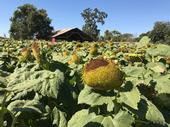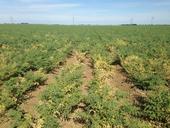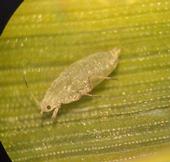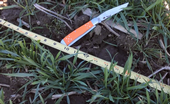- Author: Rachael Freeman Long
- Author: Sarah Light

Last year, we saw a number of disorders in sunflower that were mainly related to a heat stress by parental line interaction. Despite extensive testing by the USDA and UC ANR for pathogens in many affected sunflower plants, no causal agents were found. Overall, symptoms were found only on the female lines and were fairly uniform in plants in the heat-stress affected fields, which is another clue that the cause was abiotic or environmental, not due to a disease problem. A disease would be more random and affect both male and female lines (unless one line has resistance to the disease).
One disorder observed was foamy head rot of sunflower, a malady that produces copious white frothy material that exudes from the leaf...
- Author: Konrad Mathesius
Join us on Thursday May 17th for this year's University of California Small Grains - Alfalfa/ Forages Field Day.
The event will take place at the UC Davis Agronomy Field Headquarters on Hutchison Drive.
Registration, parking, and lunch are free.
Morning sessions will focus on recent small grains research, afternoon sessions will cover recent developments in alfalfa and forages.
CCA CEUs Approved: 1.5 for the a.m. sessions; 3 for the p.m. sessions
DPR (PCA/QAL) CEUs Pending: 0.5-0.75 for the a.m. sessions; 1.5 for the p.m. sessions
Please see full agenda for more...
- Author: Sarah Light
- Contributor: Rachael Freeman Long

With crops being planted in the field, now is a good time to refresh our knowledge of on-farm diagnostics to try to stay ahead of problems. Diagnosing on farm issues requires us to know what normal, healthy crops look like, and to observe in field clues. Crop health can be impacted by both biotic and abiotic disorders. Biotic disorders are caused by living organisms (fungi, nematodes, bacteria, viruses) while abiotic disorders are caused by non-living organisms. This includes things like herbicide damage, environmental factors (water and heat stress), nutrient deficiencies or toxicities, mechanical damage, and soil salinity issues. Biotic and abiotic disorders are...
- Author: Konrad Mathesius

Russian wheat aphids (RWA) have been sighted in some parts of western Yolo County and the Delta. RWA is an invasive species of aphid that caused a fair amount of consternation when it was introduced in the mid-80's. While some RWA is now common from year to year in California, RWA is not usually problematic for fall-planted wheat because most wheat is already in the late-boot stage by the time RWA populations are increasing, limiting their damage. However, due to precipitation patterns in the Sacramento Valley this season, some growers may have planted (or replanted) their wheat later in the season. As a result, there may be greater chances for crop damage from RWA this season on these younger...
- Author: Konrad Mathesius
- Contributor: Mark Lundy

After a dry beginning to the season wheat growers might be trying to decide how to proceed with their nitrogen fertility program. If not irrigated, most wheat planted in the Sacramento Valley during November will likely have been stunted by the relatively dry conditions during the second half of November and throughout December (see Fig. 1, below). Some of the crops out there may need to be replanted entirely. If you're trying to work out how your stand is doing, consider some population sampling.
To get a rough estimate of your field's population, take several plant counts from random locations in the field. Lay a yard stick parallel to a row and count how many plants are still present in that row. Do this several times...


